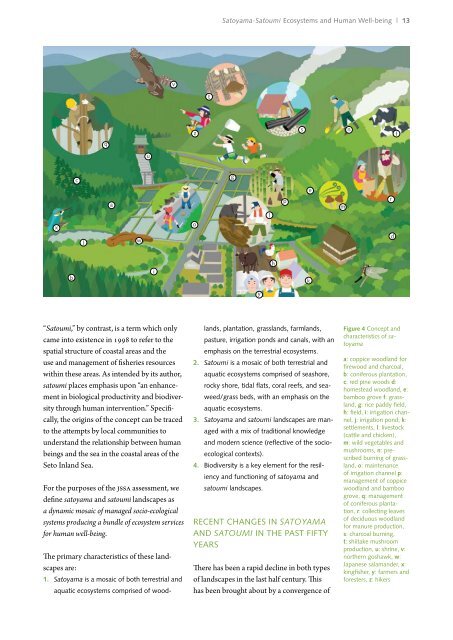Satoyama-Satoumi Ecosystems and Human Well-Being - UNU-IAS ...
Satoyama-Satoumi Ecosystems and Human Well-Being - UNU-IAS ...
Satoyama-Satoumi Ecosystems and Human Well-Being - UNU-IAS ...
You also want an ePaper? Increase the reach of your titles
YUMPU automatically turns print PDFs into web optimized ePapers that Google loves.
<strong>Satoyama</strong>-<strong>Satoumi</strong> <strong>Ecosystems</strong> <strong>and</strong> <strong>Human</strong> <strong>Well</strong>-being | 13<br />
“<strong>Satoumi</strong>,” by contrast, is a term which only<br />
came into existence in 1998 to refer to the<br />
spatial structure of coastal areas <strong>and</strong> the<br />
use <strong>and</strong> management of fisheries resources<br />
within these areas. As intended by its author,<br />
satoumi places emphasis upon “an enhancement<br />
in biological productivity <strong>and</strong> biodiversity<br />
through human intervention.” Specifically,<br />
the origins of the concept can be traced<br />
to the attempts by local communities to<br />
underst<strong>and</strong> the relationship between human<br />
beings <strong>and</strong> the sea in the coastal areas of the<br />
Seto Inl<strong>and</strong> Sea.<br />
For the purposes of the JSSA assessment, we<br />
define satoyama <strong>and</strong> satoumi l<strong>and</strong>scapes as<br />
a dynamic mosaic of managed socio-ecological<br />
systems producing a bundle of ecosystem services<br />
for human well-being.<br />
The primary characteristics of these l<strong>and</strong>scapes<br />
are:<br />
1. <strong>Satoyama</strong> is a mosaic of both terrestrial <strong>and</strong><br />
aquatic ecosystems comprised of wood-<br />
l<strong>and</strong>s, plantation, grassl<strong>and</strong>s, farml<strong>and</strong>s,<br />
pasture, irrigation ponds <strong>and</strong> canals, with an<br />
emphasis on the terrestrial ecosystems.<br />
2. <strong>Satoumi</strong> is a mosaic of both terrestrial <strong>and</strong><br />
aquatic ecosystems comprised of seashore,<br />
rocky shore, tidal flats, coral reefs, <strong>and</strong> seaweed/grass<br />
beds, with an emphasis on the<br />
aquatic ecosystems.<br />
3. <strong>Satoyama</strong> <strong>and</strong> satoumi l<strong>and</strong>scapes are managed<br />
with a mix of traditional knowledge<br />
<strong>and</strong> modern science (reflective of the socioecological<br />
contexts).<br />
4. Biodiversity is a key element for the resiliency<br />
<strong>and</strong> functioning of satoyama <strong>and</strong><br />
satoumi l<strong>and</strong>scapes.<br />
Recent changes in satoyama<br />
<strong>and</strong> satoumi in the past fifty<br />
years<br />
There has been a rapid decline in both types<br />
of l<strong>and</strong>scapes in the last half century. This<br />
has been brought about by a convergence of<br />
Figure 4 Concept <strong>and</strong><br />
characteristics of satoyama<br />
a: coppice woodl<strong>and</strong> for<br />
firewood <strong>and</strong> charcoal,<br />
b: coniferous plantation,<br />
c: red pine woods,d:<br />
homestead woodl<strong>and</strong>, e:<br />
bamboo grove,f: grassl<strong>and</strong>,<br />
g: rice paddy field,<br />
h: field, i: irrigation channel,<br />
j: irrigation pond, k:<br />
settlements, l: livestock<br />
(cattle <strong>and</strong> chicken),<br />
m: wild vegetables <strong>and</strong><br />
mushrooms, n: prescribed<br />
burning of grassl<strong>and</strong>,<br />
o: maintenance<br />
of irrigation channel,p:<br />
management of coppice<br />
woodl<strong>and</strong> <strong>and</strong> bamboo<br />
grove, q: management<br />
of coniferous plantation,<br />
r: collecting leaves<br />
of deciduous woodl<strong>and</strong><br />
for manure production,<br />
s: charcoal burning,<br />
t: shiitake mushroom<br />
production, u: shrine, v:<br />
northern goshawk, w:<br />
Japanese salam<strong>and</strong>er, x:<br />
kingfisher, y: farmers <strong>and</strong><br />
foresters, z: hikers
















